人教课标版高中英语必修1 Unit 2 English around the world单元课件(82张)
文档属性
| 名称 | 人教课标版高中英语必修1 Unit 2 English around the world单元课件(82张) | 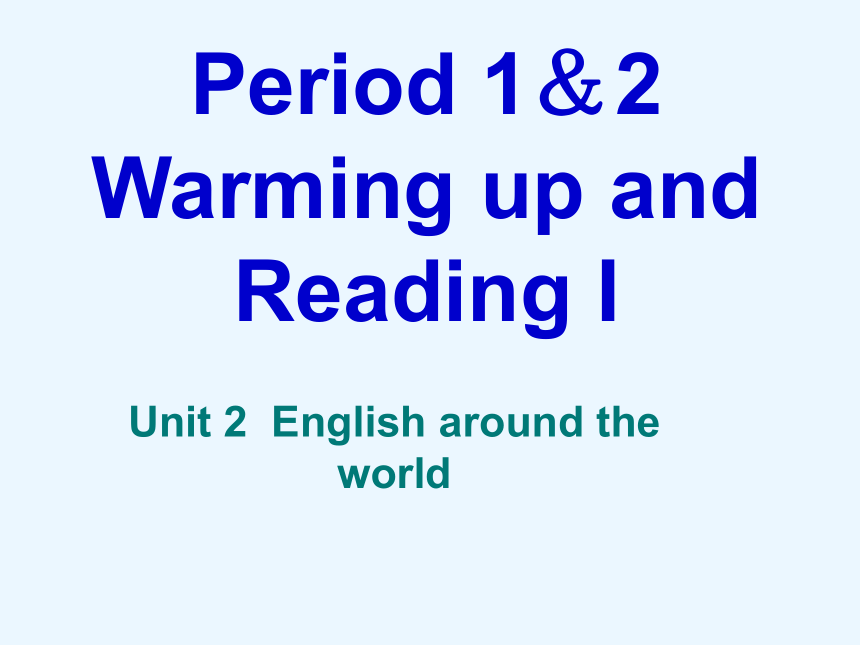 | |
| 格式 | zip | ||
| 文件大小 | 618.9KB | ||
| 资源类型 | 教案 | ||
| 版本资源 | 人教版(新课程标准) | ||
| 科目 | 英语 | ||
| 更新时间 | 2020-05-18 15:46:19 | ||
图片预览

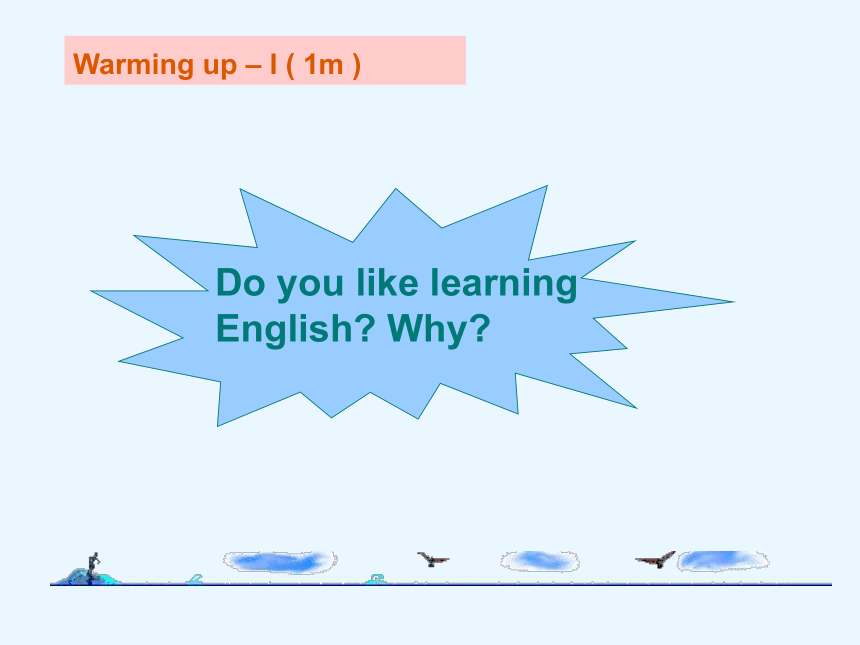



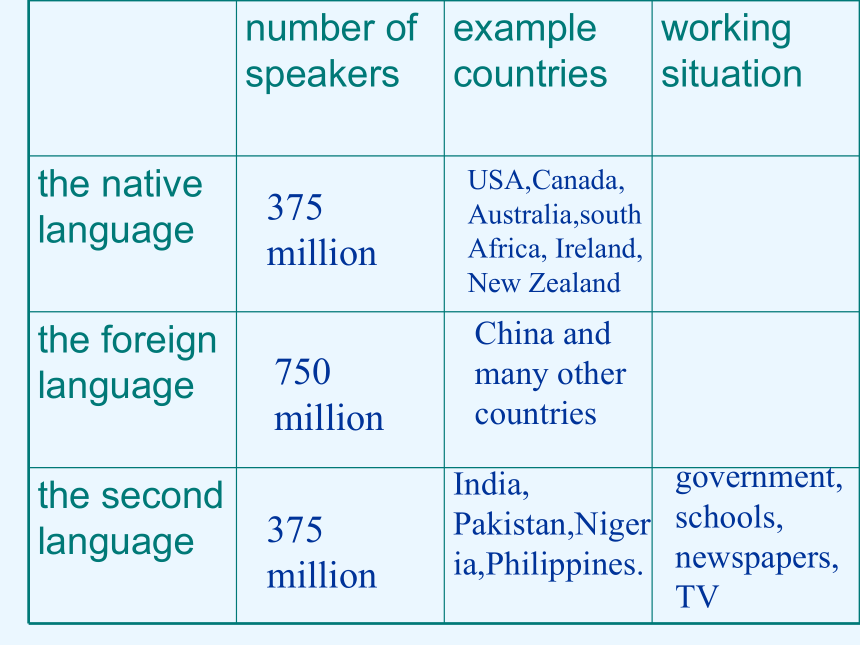
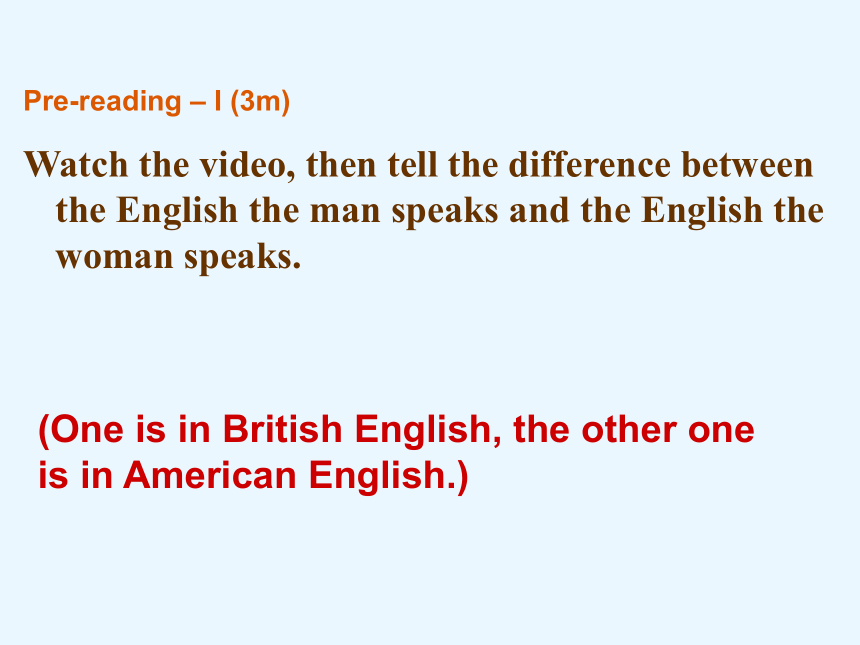

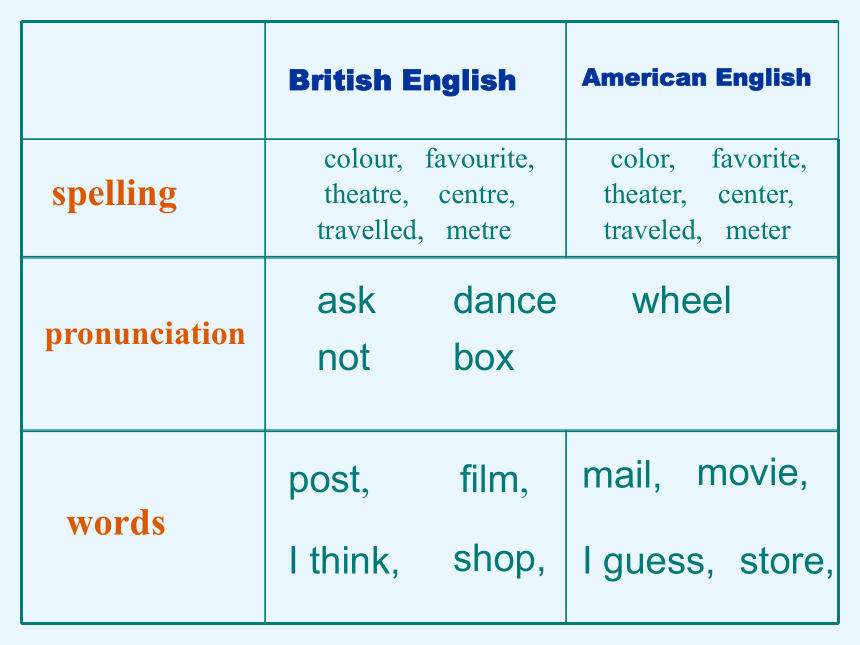
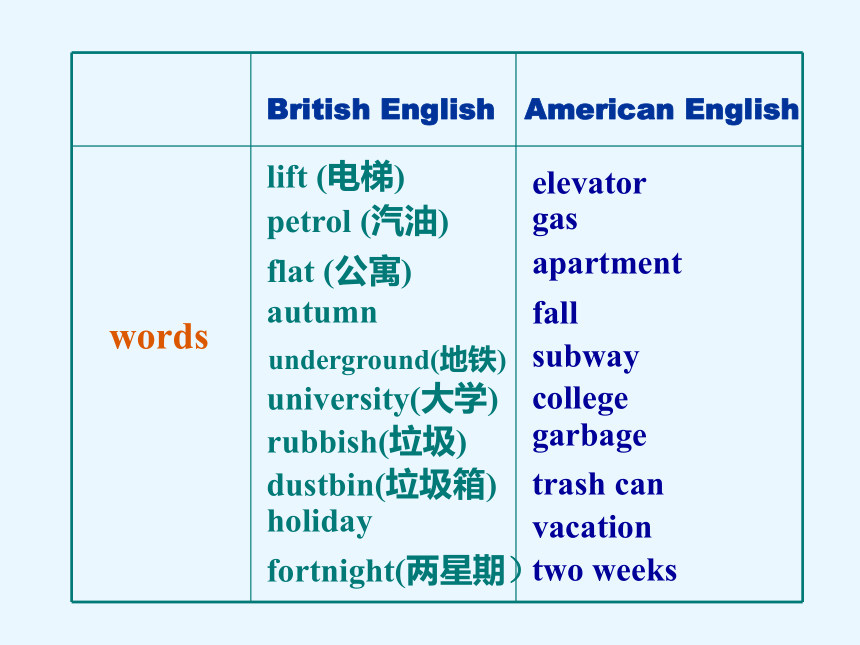


文档简介
(共82张PPT)
Period 1&2 Warming up and Reading I
Unit 2 English around the world
Do you like learning English? Why?
Warming up – I ( 1m )
1.Can you name some countries in which English is spoken?
Warming up – II ( 9m)
Read the passage in warming up, and answer the following questions?
English Around the World
the USA
Canada
New Zealand
Australia
South Africa
the United Kingdom
Ireland
3.Do you know how many people use English as their native language, second language, or foreign language?
2. Are the English in those countries the same?
375 million
750 million
375 million
USA,Canada,Australia,south Africa, Ireland, New Zealand
China and many other countries
India, Pakistan,Nigeria,Philippines.
government,schools, newspapers,TV
number of speakers example countries working situation
the native language
the foreign language
the second language
Pre-reading – I (3m)
Watch the video, then tell the difference between the English the man speaks and the English the woman speaks.
(One is in British English, the other one is in American English.)
British English
American English
&
Pre-reading – II ( 5m )
Do you know the differences between American English and British English?
British English
American English
spelling
pronunciation
words
colour,
color,
favourite,
favorite,
theatre,
theater,
centre,
center,
travelled,
traveled,
metre
meter
ask
dance
wheel
not
box
post,
mail,
film,
movie,
shop,
store,
I think,
I guess,
British English
American English
words
lift (电梯)
elevator
petrol (汽油)
gas
flat (公寓)
apartment
autumn
fall
underground(地铁)
subway
university(大学)
college
rubbish(垃圾)
garbage
dustbin(垃圾箱)
trash can
holiday
vacation
fortnight(两星期)
two weeks
Reading – I ( 3m )
Fast reading:
Read the text and find out the answers to the questions of Ex. 1 on page 10.
1. Read the text and try to find the main idea of each paragraph. (Work in pairs)
Reading – II ( 10m )
Pair work:
2. Check the answers.
Ask some students to tell their answers, after giving the answers, they should also tell how they find the answers, then give the suggested answer.
Paragraph 1: describes the extension of English in the world.
Paragraph 2: tells us native speakers can understand each other but not everything.
Paragraph 3: tells the development of English as native language.
Paragraph 4: tells us English is spoken as a foreign or second language in many countries.
Reading – III ( 5m )
Group work:
What can you learn from this passage?
(discuss in group of four, then ask the students to show their ideas.)
The aim of this step is to help the students realize the importance of English.
Post-reading ( 5m )
1. Do you think it matters what kind of English you learn, why?
2. Why do you think people all over the world want to learn English?
3. Will Chinese English become one of the World English?
(Students give their own answers.)
Assignment
1. Try to remember the English meaning of the new words in Reading I.
2. Prepare for the next class.
3. Finish the exercises on WB.
Period 3 Learning about language
Unit 2 English around the world
Revision ( 3m )
Match: (Review the new words)
1.come up
2.culture
3.actually
4.present
evidence of intellectual development of (arts, science,etc.) in human society.
reach;close to
Being in the place in question;existing now.
In actual fact;really
E. for example
F. govern;have authority (over).
G. who sb is; what sth is
H. way of using sth; treatment.
5.rule
6.usage
7.identity
8.such as
Checking answer – I (1m)
Answer keys for Ex.1 on Page 11:
1 C
2D
3E
4F
5A
6B
7J
8G
9I
10H
It is not easy for a Chinese person to speak English as well as a _____________ ________. This is _________ because the ___________ and usage are different in different parts of the English speaking world. If you say “flat" instead of “_________", people in America will not think you speak good English. If you use the word _________ instead of “lift" in Britain, they will look at you a little strangely! It seems you cannot win!
Checking answer – II (2m)
Answer keys for Ex.2 on Page11:
native English
speaker
actually
vocabulary
apartment
elevator
Checking answer – III (2m)
Answer keys for Ex. 3 on page 11:
includes
cultures
present
Actually
usage
6. gas
7. international
8. Rapidly
9. However
10. government
Learning useful structure – I ( 2m )
Say the following sentences to three students:
S1: Open the window.
S2: Pass on the book to your deskmate.
S3: Will you please close the door.
Then ask:
What is the difference among the sentences I spoke to them just now?
Help the students understand what is a command or a request.
Learning useful structure – II ( 2m )
Make clear the difference between commands and requests and finish the following exercises:
Go and collect the wood right now.
Could you go and get the shopping bags, please?
Shut the door at once.
Go and get my coat.
Would you please get that book for me?
(C)
(R)
(C)
(C)
(R)
Learning useful structure – III ( 2m )
Find the rules:Ask the students to finish the following exercises, and try to find the rules.
“Make sure the door is open.” the teacher said to me.
The teacher told me to make sure the door is open.
“Don’t play games in the classroom.” the monitor said to us.
The monitor told us not to play games in the classroom.
“Will you please not smoke here?” she added.
She asked me not to smoke here.
Learning useful structure – IV (10 m )
Rules and practice of direct and indirect speech
当直接引语为祈使句时,转换为间接引语要用一个带动词不定式的简单句表示:
祈使句
直引:主语+动词+“祈使句”
间引:主语+动词+to Verb
e.g. The teacher said to me, “Come in .”
—The teacher told me to go in 。
John said to me , “Please shut the window。”
—John asked me to shut the window。
The teacher said to me, “ Don’t be late again.”
---- The teacher advised me not to be late again.
特别提醒
1.祈使句变为间接引语,主要使用动词不定式。
2.谓语动词要做一定变化。
表示命令,用tell,order,command等。
表示请求,用ask,beg,request等。
表示忠告,用 advise。
Open the window.
Direct speech
Indirect speech
Miss Hu told ** to
open the window.
Will you please
open the window?
Miss Hu asked ** to
open the window.
told
to
asked
to
Don’t open
the window.
Miss Hu told ** not
to open the window.
not
“Write a letter to your parents.”
“Don’t play games in the classroom.”
“Can you pass on the book to Tom?”
“Will you please not smoke here?”
The teacher told me to write a letter ….
The teacher ordered me not to play games ….
The teacher asked me to pass on …
The teacher asked me not to smoke there.
Try to do this:
“It is a fine day. Let’s go to the country
for a picnic.” Peter said to me.
Peter said that it was a fine day and
asked me to go to the country for a
picnic with him.
Peter told me that it was a fine
day and let us go to the country
for a picnic.
? 感叹句
直引:主语+动词+“感叹句”
间引:主语+动词+陈述句
e.g. He said, “ what a fine day it is !”
He said , “ How fine the day is !”
He said what a fine day it was . He said how fine the day was . He exclaimed that it was a fine day.
特别提醒
1. 间接感叹句的动词应该是cry 或exclaim 。
2.可以仍用what,how 等词,语序不变,也可以用that 从句,把动词say 改为cry,shout,exclaim 等。
1.He said to Tom, “Don’t do the work any more.”
He told Tom not to do the work any more.
Practice
2.Mrs. Green said, “Please sing us a song, Miss White.”
3. “Be quiet, children.” said Mrs. Wilson.
Mrs. Green asked Miss White to sing them a song.
Mrs. Wilson told the children to be quiet.
4. All the people cried, “What magnificent clothes
these are!”
All the people cried what magnificent clothes these were.
Assignment
1. Try to remember the rules of direct and indirect speech.
2. Finish the exercises on WB.
3. Prepare for the next class.
Period 4 Reading II
Unit 2 English around the world
?
Warming up – I ( 3m )
How many dialects are there in China ?
dialects family in China
北方方言
吴语
闽南语
客家话
湘语
赣语
粤语
Chinese
dialects in
Guangdong province
粤方言
客方言
闽方言
代表地区
梅州
代表地区
广州
代表地区
潮汕地区
Warming up – II ( 2m )
Do you think there are some dialects in English?
English dialects in different countries
Britain
The U.S.A
Canada
Australia
India
New Zealand
Reading – I (1m )
Fast reading:
Read the text on page 13 for 1 minute and answer the following question.
Is there standard English?
Reading – II ( 5m )
Detailed Reading
Read the text for 3 minutes and answer the following question.
1.How many dialects of American English have been listed in the text?
2.Why do people from both Northeastern and Southeastern of U.S. speak with almost the same dialect? And what kind of dialect is it?
3.Why are there so many dialect in American English?
1.How many dialects of American English have been listed in the text?
mid-western, southern, African American, Spanish
2.Why do people from both Northeastern and Southeastern of U.S. speak with almost the same dialect?
Because when Americans moved from one place to anther, they took their dialects with them.
3.Why are there so many dialect in American English?
That’s because people come from all over the world. And geography plays a part in making dialects.
Reading – III ( 10m ) Reading Task on page 52
Read the passage on Page 51 & 52, then fill in the following form:
Country
Education
Job
Most important task
Who worked on it?
Date of completion
Other information a
Scotland
Country
Education
Job
Most important task
Who worked on it?
Date of completion
Other information
Country Scotland
Education Village school then taught himself.
Job
Most important task
Who worked on it?
Date of completion
Other information
Country Scotland
Education Village school then taught himself.
Job Work in a bank, teacher.
Most important task
Who worked on it?
Date of completion
Other information
Country Scotland
Education Village school then taught himself.
Job Work in a bank, teacher.
Most important task Its difficulties: the biggest dictionary, work in a place where it is too hot or cold, work alone at first, only used pen and paper. Qualities needed: hard work, interest in the job, patience.
Who worked on it?
Date of completion
Other information
Country Scotland
Education Village school then taught himself.
Job Work in a bank, teacher.
Most important task Its difficulties: the biggest dictionary, work in a place where it is too hot or cold, work alone at first, only used pen and paper. Qualities needed: hard work, interest in the job, patience.
Who worked on it? Murray, his two daughters and other editors.
Date of completion
Other information
Country Scotland
Education Village school then taught himself.
Job Work in a bank, teacher.
Most important task Its difficulties: the biggest dictionary, work in a place where it is too hot or cold, work alone at first, only used pen and paper. Qualities needed: hard work, interest in the job, patience.
Who worked on it? Murray, his two daughters and other editors.
Date of completion 1982
Other information
Country Scotland
Education Village school then taught himself.
Job Work in a bank, teacher.
Most important task Its difficulties: the biggest dictionary, work in a place where it is too hot or cold, work alone at first, only used pen and paper. Qualities needed: hard work, interest in the job, patience.
Who worked on it? Murray, his two daughters and other editors.
Date of completion 1982
Other information Ideas for this dictionary from a meeting in Britain in 1857. Begin to do it in 1895. Hoped to finish it in ten years.
Assignment
Review all the new words and expressions.
Finish the exercises on the exercise books.
3. Prepare for the next class.
Period 5 Listening
Unit 2 English around the world
Ask some students to tell the words that are different in American English & British English
Revision ( 2m )
Listening – I ( 5m )
Ex. 5 on Page 12.
Listen to these dialogues. Find the British and American words which are different but have the same meaning.
Dialogue 1: candy----sweets
Dialogue 2: truck----lorry
Dialogue 3: fall----autumn
Listening – II ( 13m )
Listening on Page 14.
1. Listen to the tape for the first time and try your best to get the main idea of what is talking.
2. Listen to the tape for the second time, pay attention to the exercise of page 14. Try your best to find out the answers to these questions.
Answer keys for the exercises on page 14
He believes it’s almost a different country from the US. The listening text tells us it is so.
The boys thought that the catfish was almost the size of a house..
He thought the catfish would eat him.
They laughed because Lester believed the catfish would hurt him.
Jane is the second speaker, Buford’s teacher. She is from Britain.
She says “Hello”.
Listening – III ( 10m )
Listening Task on Page 51.
1. Ask the students to tell the names of the countries where English is spoken.
2. Finish the listening task.
( Students give their own answers after listening.)
Conclusion for listening skills (10m)
After each step of listening, ask the students who did best to tell how he / she did it, other students can have a discussion or ask him / her some questions.Everyone should try his best to find a good way for himself to improve his listening ability.
Assignment
1. Finish the listening task on English Weekly.
2. Make a conclusion of the skills learned in this class.
Period 6 Speaking and writing
Unit 2 English around the world
Speaking – I (5m )
Make a dialogue
There are three situations. Please make dialogues using commands or requests with your partner. You are encouraged to imagine interesting dialogues.
Situation 1
You need to ask someone to close the door but you cannot do it yourself. There are many people in the room but you cannot tell who are important and who are not. so how do you do it politely?
Situation 2
You are standing in the middle of a train carriage and you need to leave. You must not push your way to the door, so how do you do it politely?
Situation 3
A bear is about to approach a boy. What do you say to him to make sure that he won’t be hurt?
Pre-speaking for speaking –II ( 3m )
Read the dialogue on page 15 and find out the different British and American English words.
Amy (American) Lady (British)
Read the dialogue on page 15 and find out the different British and American English words.
Amy (American) Lady (British)
subway underground
Read the dialogue on page 15 and find out the different British and American English words.
Amy (American) Lady (British)
subway underground
left left-hand side
Read the dialogue on page 15 and find out the different British and American English words.
Amy (American) Lady (British)
subway underground
left left-hand side
keep going straight go straight on
Read the dialogue on page 15 and find out the different British and American English words.
Amy (American) Lady (British)
subway underground
left left-hand side
keep going straight go straight on
two blocks two streets
Read the dialogue on page 15 and find out the different British and American English words.
Amy (American) Lady (British)
subway underground
left left-hand side
keep going straight go straight on
two blocks two streets
right right-hand side
movie
film
bar
pub
the first floor
ground floor
Amy (American) Lady (British)
subway underground
left left-hand side
keep going straight go straight on
two blocks two streets
right right-hand site
Speaking – II ( 8m ) Group work
Form a group in three , and make a dialogue according to the following map, try to use the words that are different in BE and AE as many as possible.
Student A: is from American. Don’t know the directions, so ask Student C for help. But doesn’t know the British well.
Student B: is a speaker of British English, but know both American and British English. Retell C’s words to A
Student C: is the native British there and is familiar with the directions. But doesn’t know American English.
Map
Restaurant Museum Underground
Supermarket Middle School
Pub Cinema
My experience of learning English
Writing – I ( 4m )
Pair work:Fill in the chart after discussing in pairs.
My problems Ideas for improvement Why I like English My future with English
.
.
My experience of learning English
My problems Ideas for improvement Why I like English My future with English
Listening Listen to BBC. Listen to music and movies. Help me realize my dream.
Writing Practice making sentence Enjoy original works
Words Memorize new words Travel
Writing – II ( 15m ): Write a passage:
Title:My Experience of learning English
Words: at least 100.
Content:Paragraph 1 My problem in learning English.
Paragraph 2 How I can improve my English.
Paragraph 3 What I like about learning English.
Paragraph 4 How I hope to make use of my English?
Writing – III ( 10m )
Checking the composition.
1. Ask the students to check the composition for their partner.
2. Show some compositions on the screen, other students should give some advice.
Assignment
Try to correct the composition .
Finish the exercise of unit 2 of English Weekly.
Finish the reading on page 53 and design a code of your own. (a group of 4).
Period 1&2 Warming up and Reading I
Unit 2 English around the world
Do you like learning English? Why?
Warming up – I ( 1m )
1.Can you name some countries in which English is spoken?
Warming up – II ( 9m)
Read the passage in warming up, and answer the following questions?
English Around the World
the USA
Canada
New Zealand
Australia
South Africa
the United Kingdom
Ireland
3.Do you know how many people use English as their native language, second language, or foreign language?
2. Are the English in those countries the same?
375 million
750 million
375 million
USA,Canada,Australia,south Africa, Ireland, New Zealand
China and many other countries
India, Pakistan,Nigeria,Philippines.
government,schools, newspapers,TV
number of speakers example countries working situation
the native language
the foreign language
the second language
Pre-reading – I (3m)
Watch the video, then tell the difference between the English the man speaks and the English the woman speaks.
(One is in British English, the other one is in American English.)
British English
American English
&
Pre-reading – II ( 5m )
Do you know the differences between American English and British English?
British English
American English
spelling
pronunciation
words
colour,
color,
favourite,
favorite,
theatre,
theater,
centre,
center,
travelled,
traveled,
metre
meter
ask
dance
wheel
not
box
post,
mail,
film,
movie,
shop,
store,
I think,
I guess,
British English
American English
words
lift (电梯)
elevator
petrol (汽油)
gas
flat (公寓)
apartment
autumn
fall
underground(地铁)
subway
university(大学)
college
rubbish(垃圾)
garbage
dustbin(垃圾箱)
trash can
holiday
vacation
fortnight(两星期)
two weeks
Reading – I ( 3m )
Fast reading:
Read the text and find out the answers to the questions of Ex. 1 on page 10.
1. Read the text and try to find the main idea of each paragraph. (Work in pairs)
Reading – II ( 10m )
Pair work:
2. Check the answers.
Ask some students to tell their answers, after giving the answers, they should also tell how they find the answers, then give the suggested answer.
Paragraph 1: describes the extension of English in the world.
Paragraph 2: tells us native speakers can understand each other but not everything.
Paragraph 3: tells the development of English as native language.
Paragraph 4: tells us English is spoken as a foreign or second language in many countries.
Reading – III ( 5m )
Group work:
What can you learn from this passage?
(discuss in group of four, then ask the students to show their ideas.)
The aim of this step is to help the students realize the importance of English.
Post-reading ( 5m )
1. Do you think it matters what kind of English you learn, why?
2. Why do you think people all over the world want to learn English?
3. Will Chinese English become one of the World English?
(Students give their own answers.)
Assignment
1. Try to remember the English meaning of the new words in Reading I.
2. Prepare for the next class.
3. Finish the exercises on WB.
Period 3 Learning about language
Unit 2 English around the world
Revision ( 3m )
Match: (Review the new words)
1.come up
2.culture
3.actually
4.present
evidence of intellectual development of (arts, science,etc.) in human society.
reach;close to
Being in the place in question;existing now.
In actual fact;really
E. for example
F. govern;have authority (over).
G. who sb is; what sth is
H. way of using sth; treatment.
5.rule
6.usage
7.identity
8.such as
Checking answer – I (1m)
Answer keys for Ex.1 on Page 11:
1 C
2D
3E
4F
5A
6B
7J
8G
9I
10H
It is not easy for a Chinese person to speak English as well as a _____________ ________. This is _________ because the ___________ and usage are different in different parts of the English speaking world. If you say “flat" instead of “_________", people in America will not think you speak good English. If you use the word _________ instead of “lift" in Britain, they will look at you a little strangely! It seems you cannot win!
Checking answer – II (2m)
Answer keys for Ex.2 on Page11:
native English
speaker
actually
vocabulary
apartment
elevator
Checking answer – III (2m)
Answer keys for Ex. 3 on page 11:
includes
cultures
present
Actually
usage
6. gas
7. international
8. Rapidly
9. However
10. government
Learning useful structure – I ( 2m )
Say the following sentences to three students:
S1: Open the window.
S2: Pass on the book to your deskmate.
S3: Will you please close the door.
Then ask:
What is the difference among the sentences I spoke to them just now?
Help the students understand what is a command or a request.
Learning useful structure – II ( 2m )
Make clear the difference between commands and requests and finish the following exercises:
Go and collect the wood right now.
Could you go and get the shopping bags, please?
Shut the door at once.
Go and get my coat.
Would you please get that book for me?
(C)
(R)
(C)
(C)
(R)
Learning useful structure – III ( 2m )
Find the rules:Ask the students to finish the following exercises, and try to find the rules.
“Make sure the door is open.” the teacher said to me.
The teacher told me to make sure the door is open.
“Don’t play games in the classroom.” the monitor said to us.
The monitor told us not to play games in the classroom.
“Will you please not smoke here?” she added.
She asked me not to smoke here.
Learning useful structure – IV (10 m )
Rules and practice of direct and indirect speech
当直接引语为祈使句时,转换为间接引语要用一个带动词不定式的简单句表示:
祈使句
直引:主语+动词+“祈使句”
间引:主语+动词+to Verb
e.g. The teacher said to me, “Come in .”
—The teacher told me to go in 。
John said to me , “Please shut the window。”
—John asked me to shut the window。
The teacher said to me, “ Don’t be late again.”
---- The teacher advised me not to be late again.
特别提醒
1.祈使句变为间接引语,主要使用动词不定式。
2.谓语动词要做一定变化。
表示命令,用tell,order,command等。
表示请求,用ask,beg,request等。
表示忠告,用 advise。
Open the window.
Direct speech
Indirect speech
Miss Hu told ** to
open the window.
Will you please
open the window?
Miss Hu asked ** to
open the window.
told
to
asked
to
Don’t open
the window.
Miss Hu told ** not
to open the window.
not
“Write a letter to your parents.”
“Don’t play games in the classroom.”
“Can you pass on the book to Tom?”
“Will you please not smoke here?”
The teacher told me to write a letter ….
The teacher ordered me not to play games ….
The teacher asked me to pass on …
The teacher asked me not to smoke there.
Try to do this:
“It is a fine day. Let’s go to the country
for a picnic.” Peter said to me.
Peter said that it was a fine day and
asked me to go to the country for a
picnic with him.
Peter told me that it was a fine
day and let us go to the country
for a picnic.
? 感叹句
直引:主语+动词+“感叹句”
间引:主语+动词+陈述句
e.g. He said, “ what a fine day it is !”
He said , “ How fine the day is !”
He said what a fine day it was . He said how fine the day was . He exclaimed that it was a fine day.
特别提醒
1. 间接感叹句的动词应该是cry 或exclaim 。
2.可以仍用what,how 等词,语序不变,也可以用that 从句,把动词say 改为cry,shout,exclaim 等。
1.He said to Tom, “Don’t do the work any more.”
He told Tom not to do the work any more.
Practice
2.Mrs. Green said, “Please sing us a song, Miss White.”
3. “Be quiet, children.” said Mrs. Wilson.
Mrs. Green asked Miss White to sing them a song.
Mrs. Wilson told the children to be quiet.
4. All the people cried, “What magnificent clothes
these are!”
All the people cried what magnificent clothes these were.
Assignment
1. Try to remember the rules of direct and indirect speech.
2. Finish the exercises on WB.
3. Prepare for the next class.
Period 4 Reading II
Unit 2 English around the world
?
Warming up – I ( 3m )
How many dialects are there in China ?
dialects family in China
北方方言
吴语
闽南语
客家话
湘语
赣语
粤语
Chinese
dialects in
Guangdong province
粤方言
客方言
闽方言
代表地区
梅州
代表地区
广州
代表地区
潮汕地区
Warming up – II ( 2m )
Do you think there are some dialects in English?
English dialects in different countries
Britain
The U.S.A
Canada
Australia
India
New Zealand
Reading – I (1m )
Fast reading:
Read the text on page 13 for 1 minute and answer the following question.
Is there standard English?
Reading – II ( 5m )
Detailed Reading
Read the text for 3 minutes and answer the following question.
1.How many dialects of American English have been listed in the text?
2.Why do people from both Northeastern and Southeastern of U.S. speak with almost the same dialect? And what kind of dialect is it?
3.Why are there so many dialect in American English?
1.How many dialects of American English have been listed in the text?
mid-western, southern, African American, Spanish
2.Why do people from both Northeastern and Southeastern of U.S. speak with almost the same dialect?
Because when Americans moved from one place to anther, they took their dialects with them.
3.Why are there so many dialect in American English?
That’s because people come from all over the world. And geography plays a part in making dialects.
Reading – III ( 10m ) Reading Task on page 52
Read the passage on Page 51 & 52, then fill in the following form:
Country
Education
Job
Most important task
Who worked on it?
Date of completion
Other information a
Scotland
Country
Education
Job
Most important task
Who worked on it?
Date of completion
Other information
Country Scotland
Education Village school then taught himself.
Job
Most important task
Who worked on it?
Date of completion
Other information
Country Scotland
Education Village school then taught himself.
Job Work in a bank, teacher.
Most important task
Who worked on it?
Date of completion
Other information
Country Scotland
Education Village school then taught himself.
Job Work in a bank, teacher.
Most important task Its difficulties: the biggest dictionary, work in a place where it is too hot or cold, work alone at first, only used pen and paper. Qualities needed: hard work, interest in the job, patience.
Who worked on it?
Date of completion
Other information
Country Scotland
Education Village school then taught himself.
Job Work in a bank, teacher.
Most important task Its difficulties: the biggest dictionary, work in a place where it is too hot or cold, work alone at first, only used pen and paper. Qualities needed: hard work, interest in the job, patience.
Who worked on it? Murray, his two daughters and other editors.
Date of completion
Other information
Country Scotland
Education Village school then taught himself.
Job Work in a bank, teacher.
Most important task Its difficulties: the biggest dictionary, work in a place where it is too hot or cold, work alone at first, only used pen and paper. Qualities needed: hard work, interest in the job, patience.
Who worked on it? Murray, his two daughters and other editors.
Date of completion 1982
Other information
Country Scotland
Education Village school then taught himself.
Job Work in a bank, teacher.
Most important task Its difficulties: the biggest dictionary, work in a place where it is too hot or cold, work alone at first, only used pen and paper. Qualities needed: hard work, interest in the job, patience.
Who worked on it? Murray, his two daughters and other editors.
Date of completion 1982
Other information Ideas for this dictionary from a meeting in Britain in 1857. Begin to do it in 1895. Hoped to finish it in ten years.
Assignment
Review all the new words and expressions.
Finish the exercises on the exercise books.
3. Prepare for the next class.
Period 5 Listening
Unit 2 English around the world
Ask some students to tell the words that are different in American English & British English
Revision ( 2m )
Listening – I ( 5m )
Ex. 5 on Page 12.
Listen to these dialogues. Find the British and American words which are different but have the same meaning.
Dialogue 1: candy----sweets
Dialogue 2: truck----lorry
Dialogue 3: fall----autumn
Listening – II ( 13m )
Listening on Page 14.
1. Listen to the tape for the first time and try your best to get the main idea of what is talking.
2. Listen to the tape for the second time, pay attention to the exercise of page 14. Try your best to find out the answers to these questions.
Answer keys for the exercises on page 14
He believes it’s almost a different country from the US. The listening text tells us it is so.
The boys thought that the catfish was almost the size of a house..
He thought the catfish would eat him.
They laughed because Lester believed the catfish would hurt him.
Jane is the second speaker, Buford’s teacher. She is from Britain.
She says “Hello”.
Listening – III ( 10m )
Listening Task on Page 51.
1. Ask the students to tell the names of the countries where English is spoken.
2. Finish the listening task.
( Students give their own answers after listening.)
Conclusion for listening skills (10m)
After each step of listening, ask the students who did best to tell how he / she did it, other students can have a discussion or ask him / her some questions.Everyone should try his best to find a good way for himself to improve his listening ability.
Assignment
1. Finish the listening task on English Weekly.
2. Make a conclusion of the skills learned in this class.
Period 6 Speaking and writing
Unit 2 English around the world
Speaking – I (5m )
Make a dialogue
There are three situations. Please make dialogues using commands or requests with your partner. You are encouraged to imagine interesting dialogues.
Situation 1
You need to ask someone to close the door but you cannot do it yourself. There are many people in the room but you cannot tell who are important and who are not. so how do you do it politely?
Situation 2
You are standing in the middle of a train carriage and you need to leave. You must not push your way to the door, so how do you do it politely?
Situation 3
A bear is about to approach a boy. What do you say to him to make sure that he won’t be hurt?
Pre-speaking for speaking –II ( 3m )
Read the dialogue on page 15 and find out the different British and American English words.
Amy (American) Lady (British)
Read the dialogue on page 15 and find out the different British and American English words.
Amy (American) Lady (British)
subway underground
Read the dialogue on page 15 and find out the different British and American English words.
Amy (American) Lady (British)
subway underground
left left-hand side
Read the dialogue on page 15 and find out the different British and American English words.
Amy (American) Lady (British)
subway underground
left left-hand side
keep going straight go straight on
Read the dialogue on page 15 and find out the different British and American English words.
Amy (American) Lady (British)
subway underground
left left-hand side
keep going straight go straight on
two blocks two streets
Read the dialogue on page 15 and find out the different British and American English words.
Amy (American) Lady (British)
subway underground
left left-hand side
keep going straight go straight on
two blocks two streets
right right-hand side
movie
film
bar
pub
the first floor
ground floor
Amy (American) Lady (British)
subway underground
left left-hand side
keep going straight go straight on
two blocks two streets
right right-hand site
Speaking – II ( 8m ) Group work
Form a group in three , and make a dialogue according to the following map, try to use the words that are different in BE and AE as many as possible.
Student A: is from American. Don’t know the directions, so ask Student C for help. But doesn’t know the British well.
Student B: is a speaker of British English, but know both American and British English. Retell C’s words to A
Student C: is the native British there and is familiar with the directions. But doesn’t know American English.
Map
Restaurant Museum Underground
Supermarket Middle School
Pub Cinema
My experience of learning English
Writing – I ( 4m )
Pair work:Fill in the chart after discussing in pairs.
My problems Ideas for improvement Why I like English My future with English
.
.
My experience of learning English
My problems Ideas for improvement Why I like English My future with English
Listening Listen to BBC. Listen to music and movies. Help me realize my dream.
Writing Practice making sentence Enjoy original works
Words Memorize new words Travel
Writing – II ( 15m ): Write a passage:
Title:My Experience of learning English
Words: at least 100.
Content:Paragraph 1 My problem in learning English.
Paragraph 2 How I can improve my English.
Paragraph 3 What I like about learning English.
Paragraph 4 How I hope to make use of my English?
Writing – III ( 10m )
Checking the composition.
1. Ask the students to check the composition for their partner.
2. Show some compositions on the screen, other students should give some advice.
Assignment
Try to correct the composition .
Finish the exercise of unit 2 of English Weekly.
Finish the reading on page 53 and design a code of your own. (a group of 4).
